Holden HQ Monaro racer









































|

|

|

|

|

|

|

|

|

|

|

|

|

|

|

|

|

|

|

|
There were few Monaro coupes raced in the 70s but they were successful
While it’s true that some of the greatest technological advances the world has ever seen have been the result of happy accidents or chance observations, it’s equally true that it’s the planet’s t-crossers and i-dotters that take concepts from raw ideas to finely-tuned end results.
I mean, sure, Charles Goodyear lucked on to vulcanised rubber way back in 1839 when he accidentally dropped some rubber mixed with sulphur onto a hot stove and discovered the combination allowed the rubber to maintain its structure. Fine, but in the almost two centuries since, it’s been teams of meticulous lab-dwellers working with clipboards and computers that have allowed us to arrive at the P-Zeroes, Conti Sport Contacts and semi-slicks we know and love today.
.jpg)
Hard to imagine a better backdrop at any track, anywhere
I’m not really sure who came up with the idea of racing an HQ Holden (although it was a bunch of fellas in Tasmania that created the successful one-make series that’s been entertaining us for the last three decades) but it’s people like brothers Mark and David Tessari and a couple of mates that have finessed the pursuit into an art form.
The first application of logic to the lad’s racing career came a few years after they’d been racing karts. And as anybody in karting will tell you, small does not mean inexpensive. Says David: "We got to the point in karts where we realised that, for the same dollars, we could get into cars."
| Read next: Bob Jane Holden HQ Monaro racer
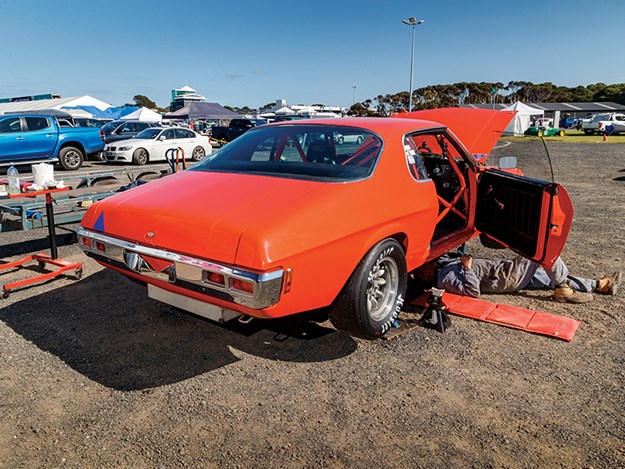
The pits, aptly named
"So we decided to get into the 202 (cubic-inch) HQ series. Except we bought the cheapest car we could find and then spent a fortune getting it right."
But even with playing catch-up with the car itself, the boys soon proved themselves to be pretty handy wheelers of the old ex-taxis. Neither was it just the David and Mark show; a couple of very good mates with the right knowledge and contacts also form part of what’s become known as The Gang.
| Buyer's Guide: Holden HQ Monaro GTS

After just a short time in the series, The Gang’s two-car team had taken out first and third places in the 2015 Australian series championship. It’s no surprise then, to learn that The Gang has a soft spot for the good old HQ Holden.
"Actually, it’s not a soft spot as much as we have a container load of spares," says Mark. And that fact, pretty neatly, led the boys to their next challenge. "We figured we could go historic touring-car racing and, if we used an HQ, we didn’t have to buy any spares." There’s also the fact that David recalls being an impressed five-year-old with Group NC race cars (which the car now races in, in historic events). The die was cast.
| Read next: 50 years of Holden HQ Monaro

The Gang started looking for a suitable vehicle with which to take its next step and finally stumbled on a 1971 HQ Coupe. Originally built by Paul Stubber in WA in 2006, the car then passed through a few pairs of mitts before landing at The Gang’s Melbourne workshop. While there was no doubt that the Stubber-built HQ had been constructed to high standards when it was first built, it was also clear that subsequent owners hadn’t always kept it as fresh as they might have.
"The previous drivers had been successful with it," says Mark, "It was always a fast car, but never perfected and, as it aged, it wasn’t refurbished. But that was okay because the HQ series had taught us not just about driving a race car, but also about preparing one."
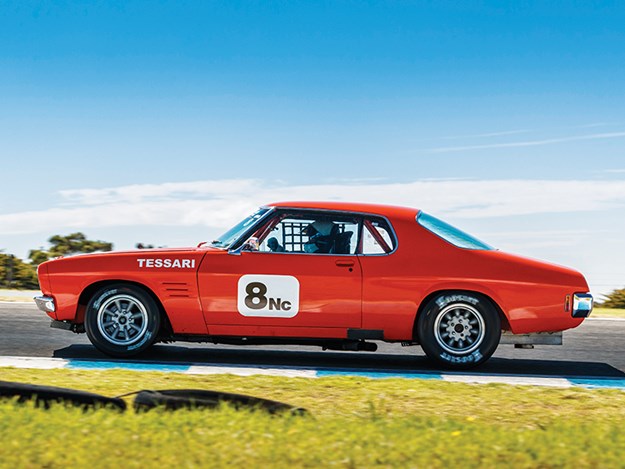
And it’s right at this point that you see where the boys became the perfectionists they now are. Since buying the car in 2017, they’ve rebuilt it twice in the name of speed and reliability. And perfection.
"Everything was there to go fast, but it needed finessing… blueprinting. Of course, that soon becomes a can of worms…"
"We eventually taught ourselves all about things like ride height, corner weighting, spring rates, geometry and refining the driveline. When we got it, the car was even set up for radial tyres. But at some stage, somebody had moved it on to Hoosiers (a cross-ply tyre with a much higher profile)."

Must be the Belmont given the sparse cabin
"These days, if the car isn’t right, it doesn’t go on the track," says Mark. "We also keep a lot of notes from each session and race. We take a methodical approach," says David. "Last couple of years have been all about refining and re-engineering the setup. Let’s call it fine-tuning."
So what spec is the old girl these days? Well, starting with the engine it’s a 350 Chev small-block with cast-iron everything. Carburation is down to a period-correct set-up consisting of nothing more spectacular than a single four-barrel. Well, if you ignore the fact that it’s similar to the carbs NASCAR was using up to a few years ago. You know the one; 9500rpm for 500 miles through a restrictor plate…
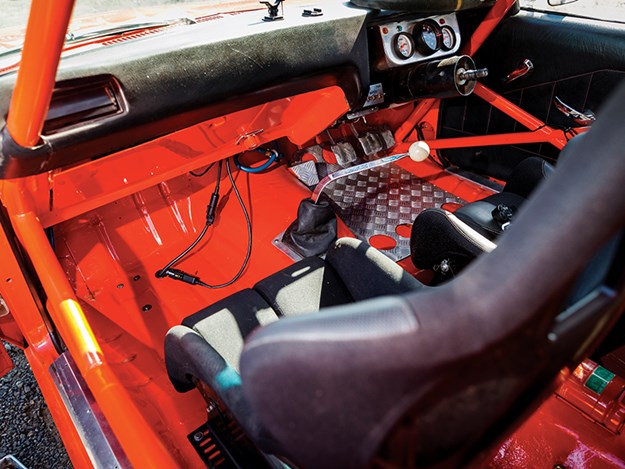
Tranny is Muncie M22, the 10-bolt diff runs 3.55:1 gears and the old dear will run out to about 7000rpm (peak power is 6500rpm) which is a fraction under 270km/h into Turn One at Philip Island.
Up close, it’s like any other (or, most any other) race car. There are a few battle scars here and there and the thing is built for speed not looks. But unlike a lot of other racers, when you get really close, the attention to detail starts to shine through, and you can understand how this Nth-degree approach pays off when the flag drops.
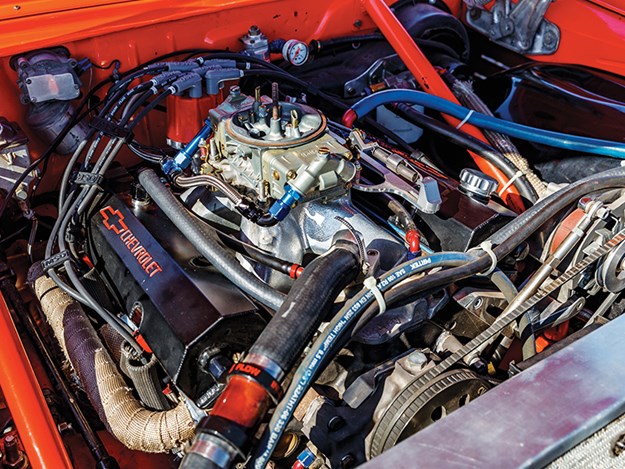
Chev 350 provides the mumbo
To say that the Tessari brothers and their gang members are not typical motorsport characters is true on the surface, but deep down, it’s that desire to squeeze every km/h and kW out of an engine that drives them.
Which is why they’re planning a new engine for next season. And here’s how you know that maybe, at their core, they are just like the rest of us: They plan to be bringing home the heads and pistons as carry-on luggage when they next travel to the States. That and the fact that tearing down a piece of hot mix in an HQ coupe, banging on the door of 170 miles-per-hour, with a small-block Chev wailing under them is the lads’ idea of a perfect day out.
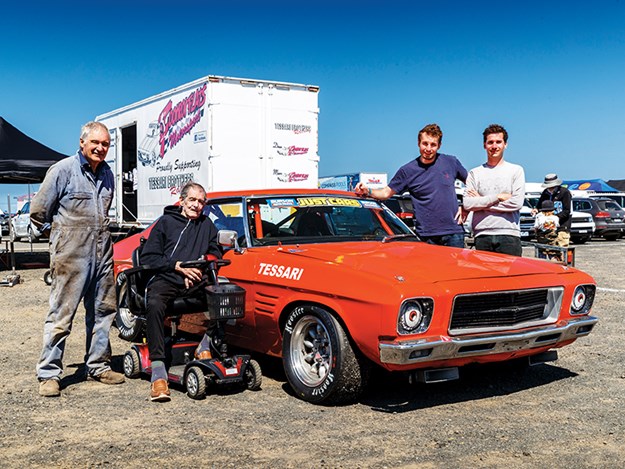
Mark and David on the right with their superbly turned out HQ Monaro
1971 HOLDEN HQ COUPE RACER
Body: Three-door coupe
Engine: 5735cc V8
Top speed: 270 km/h (approx)
Tansmission: 4-speed manual
Differential: 10-bolt diff
From Unique Cars #471, Oct/Nov 2022
Unique Cars magazine Value Guides
Sell your car for free right here
Get your monthly fix of news, reviews and stories on the greatest cars and minds in the automotive world.
Subscribe

.jpg)





.jpg)




.jpg)

